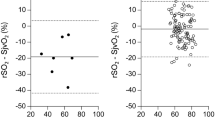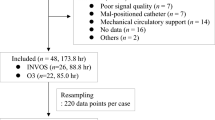Abstract
Objectives
This observational, prospective pediatric human study was performed to determine the agreement between brain tissue oxygenation indices (TOI) measured by near infrared spatially resolved spectroscopy and jugular bulb oxygen saturation values (SjO2).
Methods
Five cardiac patients without neurological impairment who were admitted into the critical care unit after open-heart surgery with jugular bulb venous catheters were enrolled. Their mean age was 8.6 months and mean body weight was 6.7 kg. Simultaneous measurements of brain TOI using NIR0-300 (Hamamatsu Photonics, Hamamatsu City, Japan) and SjO2 values from blood samples were recorded.
Results
The TOI range was 59±9% and the SjO2 range was 58±17%. The correlation coefficient R was 0.64 (p=0.11; n=14). Bland–Altman plotting revealed a bias of −3.4%, and precision of 7.2% (n=14). Intra-class correlation reliability analysis showed kappa of 0.55.
Conclusion
Statistically, brain TOI was in reasonable agreement with SjO2 in pediatric patients with normal brain within the measurement range from 50 to 70%.


Similar content being viewed by others
References
Smythe PR, Samra SK (2002) Monitors of cerebral oxygenation. Anesthesiol Clin North Am 20:293–313
Cruz J (1998) The first decade of continuous monitoring of jugular bulb oxyhemoglobin saturation: management strategies and clinical outcome. Crit Care Med 26:344–351
Gopinath SP, Robertson CS, Chance B et al (1995) Early detection of delayed traumatic intracranial hematomas using near infrared spectroscopy. J Neurosurg 83:438–444
Keller E, Nadler A, Yonekawa Y (2002) New methods for monitoring cerebral oxygenation and hemodynamics in patients with subarachnoid hemorrhage. Acta Neurochir Suppl 82:87–92
Nielsen HB, Larsen FS (2003) Cerebral oxygenation determined by near-infrared spectrophotometry in patients with fulminant hepatic failure. J Hepatol 38:188–192
Kirkpatrick PJ, Smielewski P, Pickard JD et al (1995) Near infrared spectroscopy use in patients with head injury. J Neurosurg 83:963–970
Jobsis FF (1977) Noninvasive, infrared monitoring of cerebral and myocardial oxygen sufficiency and circulatory parameters. Science 198:1264–1267
Bissonnette B, Gilder F, Black M et al (2000) Cerebral hyperthermia in children after cardiopulmonary bypass. Anesthesiology 93:611–618
Goetting MG, Preston G (1990) Jugular bulb catheterization: experience with 123 patients. Crit Care Med 18:1220–1223
Van der Zee P, Cope M, Reynolds EO et al (1992) Experimentally measured optical pathlengths for the adult head, calf and forearm and the head of the newborn infant as a function of interoptode spacing. Adv Exp Med Biol 316:143–153
Bland JM, Altman DG (1986) Statistical methods for assessing agreement between two methods of clinical measurement. Lancet 1(8476):307–310
Landis JR, Koch GG (1977) The measurement of observer agreement for categorical data. Biometrics 33:159–174
Cope M, Delpy DT (1988) A system for long-term measurement of cerebral blood and tissue oxygenation in newborn infants by near infrared transillumination. Med Biol Eng Comput 26:289–294
Suzuki S, Ozaki T, Kobayashi Y et al (1999) A tissue oxygenation monitor using NIR spatially resolved spectroscopy. Proc SPIE 3597:582–592
Watzman HM, Kurth CD, Nicolson SC et al (2000) Arterial and venous contributions to near infrared cerebral oximetry. Anesthesiology 93:947–953
Daubeney PEF, Pilkington SN, Webber SA et al (1996) Cerebral oxygenation measured by near-infrared spectroscopy: comparison with jugular bulb oximetry. Ann Thorac Surg 61:930–934
Ali MS, Harmer M, Latto IP et al (2001) Spatially resolved spectroscopy does not agree with jugular bulb oxygen saturation in patients undergoing warm bypass surgery. Can J Anaesth 48:497–501
Van den Brink WA, Van Santbrink H, Maas AIR et al (2000) Brain oxygen tension in severe head injury. Neurosurgery 46:868–876
Lam JM, Chan MS, Poon WS (1996) Cerebral venous oxygen saturation monitoring: is dominant jugular bulb cannulation good enough? Br J Neurosurg 10:357–364
Metz C, Holzschuh M, Brawanski A et al (1998) Monitoring of cerebral oxygen metabolism in the jugular bulb: reliability of unilateral measurement in severe head injury. J Cereb Blood Flow Metab 18:332–343
Acknowledgements
The authors highly appreciate Dr. Derec Stephan for his suggestions and statistical analysis of this work.
Author information
Authors and Affiliations
Corresponding author
Rights and permissions
About this article
Cite this article
Shimizu, N., Gilder, F., Bissonnette, B. et al. Brain tissue oxygenation index measured by near infrared spatially resolved spectroscopy agreed with jugular bulb oxygen saturation in normal pediatric brain: a pilot study. Childs Nerv Syst 21, 181–184 (2005). https://doi.org/10.1007/s00381-004-1079-z
Received:
Published:
Issue Date:
DOI: https://doi.org/10.1007/s00381-004-1079-z




